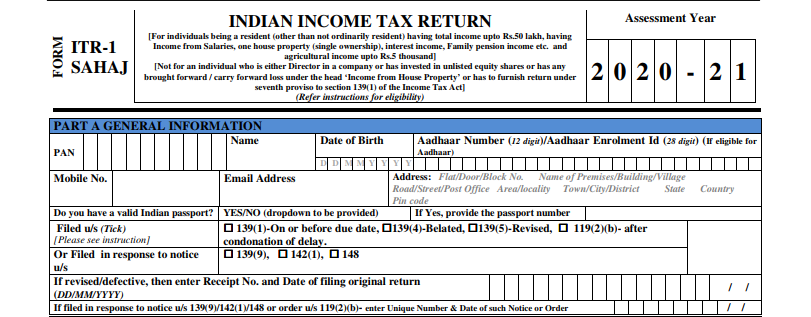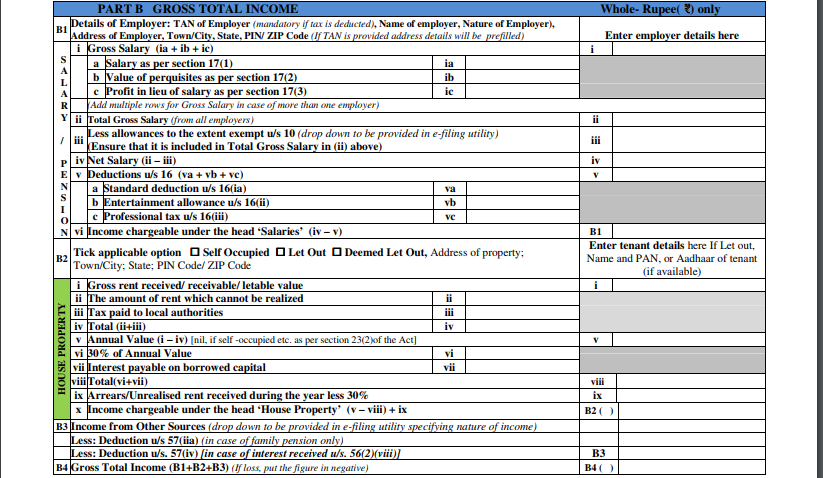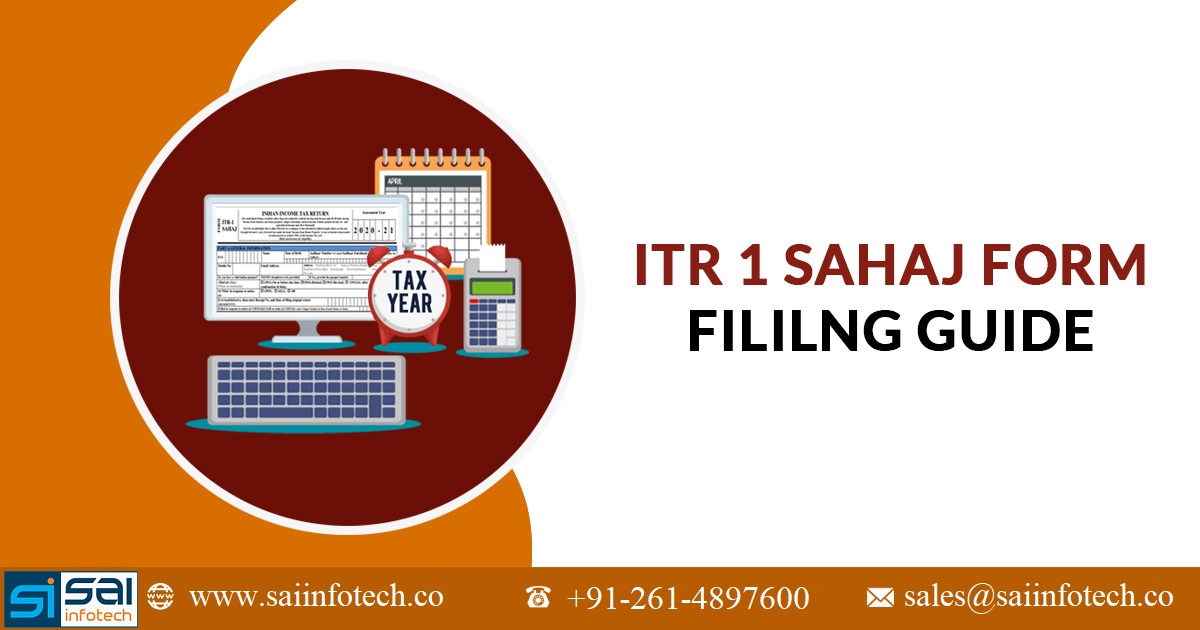What is the Income Tax Return (ITR) 1 Form?
ITR 1 Form is filed by the taxpayers and the individuals being a Resident (other than Not Ordinarily Resident) having Total Income up to INR 50 lakhs, having Income from Salaries, One House Property, Other Sources (Interest etc.), and Agricultural Income up to INR 5 thousand. (Not for an Individual who is either Director in a company or has invested in Unlisted Equity Shares). Also to note down, from now onwards, as mentioned by the tax department, furnishing PAN and Aadhaar card details on the official website of the Income Tax Department is mandatory.
The income tax department has notified ITR forms for taxpayers based on their source of income in order to create a simple tax compliance structure. Therefore, you are required to furnish the return as per the source of your income.
Read Also: Gen IT Software – Fastest & Easy Income Tax Return E-Filing Software
Eligibility To File ITR 1 Online For AY 2020-21
ITR-1 is filed by the taxpayers whose income is up to Rs 50 lakhs from below-mentioned sources:
- If the income is from one house property (the case where losses of previous years are carried forward are not included in this ITR)
- If the source of income is pension or salary
- If the source of income is other sources
- If the clubbed income of minor or wife is shown, then ITR-1 can be filed only in case their source of income as mentioned in the above points.
Not Eligible for ITR 1 Filing Online for AY 2020-21
- if an individual earns upto Rs 50 lakhs annually, but also have a house, deposited more than Rs 1 crore in a bank account or incurred Rs 200,000 on foreign travel or Rs 100,000 on electricity he/she has to file ITR 4-Sugam form.(Inserted).
- Assessee who has to furnish return under 7 th proviso to Section 139(1) of the Income Tax Act (Inserted.)
- For the assessment year 2020-21, an individual, or Hindu Undivided Family, which has joint ownership of a house property, cannot file return of income in ITR -1.
- Such person will have to file return in ITR-2 or ITR-3, as the case may be.
- The taxpayer whose income is more than Rs 50 lakhs is not eligible to furnish this form.
- Non-residents and RNOR (Residents not ordinarily resident) cannot file ITR 1.
- Taxpayers who have two or more house properties are not eligible.
- Assessees having income under business or profession head are not eligible.
- Taxpayers who have long or short-term capital gains
- Taxpayers whose income from agriculture means is greater than Rs. 5,000
- The taxpayer who claims relief for foreign taxes paid or claim double taxation relief as mentioned in section 90/90A/91.
- ITR 1 cannot be used by residents having any asset (including financial interest in any entity) located outside India or signing authority in any account located outside India.
Penalty if Miss the Income Tax Return Filing Deadline
As per revised rules under section 234F of IT act from 1st April, 2017 notifies that an individual is liable to pay maximum INR 10,000 penalty after missing the 31st July deadline of ITR filing. While in case an individual total income does not exceed 5 lakhs then a penalty of only INR 1,000 is applicable.
| Late Filing Fee Details | ||
|---|---|---|
| E- Filing Date | Total Income Below INR 5,00,000 | Total Income Above INR 5,00,000 |
| 31st July 2019 | INR 0 | INR 0 |
| Between 1st August to 31st Dec 2019 | INR 1,000 | INR 5,000 |
| Between 1st Jan 2020 to 31st March 2020 | INR 1,000 | INR 10,000 |
Modifications Details in ITR 1 Sahaj Form
- INR 50,000 standard deductions
- No applicability on directors of any company
- No applicability on individuals holding unlisted equity shares of any company
- No changes in computation
- ITR 1 & ITR 4 offline availability for senior-most citizens aged more than 80 years
- Section wise return filing is segregated within the normal filing return and response to the notice
- Salary bifurcation will be done as the standard deduction, entertainment allowance and professional tax
- Pensioners column has been added in the nature of employment
- Part A General Information requires the details of Valid Indian Passport to be filled by the Assessee.
- Details of Employer like TAN of Employer (mandatory if tax is deducted), Name of employer, Nature of Employer), Address of Employer, Town/City, State, PIN/ ZIP Code has been inserted under the head income from salary.
- Deletion of details of Return of Income filed in response to notice u/s 153A and 153C.
- A new deduction of 80CCC,80CCD(1), 80CCD(1B), 80CCD(2),
80DD,80DDB,80E,80EE,80EEA,80EEB,80GG,80GGC,80U has been added in thedeductions column. - A new deduction u/s 57(iv) in case of interest u/s 56(2)(viii) under the head Income from other sources has been inserted.
- Point of the amount of rent which cannot be realized has been inserted under the head house property.
- The individual income from one house property, salaries and other sources summing up to 50 lakhs, this condition retains its place even after changes
Due Date for Filing ITR 1 Online AY 2020-21
- Every year ITR -1 has to be filed on or before 31st July of the following year. After that, a late fee under section 234F is levied
- Applicable Income Tax Rates for FY 2019-20 (AY 2020-21)
Guide to File Income Tax Return (ITR) 1 Online:
ITR 1 is divided into 7 sections where:
Part A – General Information

This tab includes details of the following general fields:
- Name
- Address
- PAN number
- Mobile no.
- Email address
- Aadhar number
- Return filing details
- Nature of employment viz Govt/PSU/Pensioners/Other
- Details of Valid Indian Passport
Part B – Gross total income

Part B1
- Details of Employer like TAN , Name, Nature& Address of Employer
- Salary details
- All the allowances which are exempted
- All the value of perquisites
- Net salary
- Deduction in u/s 16
- Income chargeable under the head ‘salaries’
Part B2
- Gross Rent received
- The amount of Rent which cannot be realized
- Tax paid to local authorities
- Annual value
- 30% of the annual value
- Interest payable on borrowed capital
- Arrears/unrealized rent less than 30%
- Income chargeable under head ‘house property’
Part B3
- Deduction u/s 57(iia)
- Deduction u/s 57(iv)(in case of interest received u/s 56(2)(viii)
Part B4 – Gross total income
- (B1 + B2 + B3)
Part C – Deductions u/c VI-A and Taxable total income

This tab includes all the deductions and taxable total income
Here the deduction limit will be as per income tax act
- 80C,80CCC,80CCD(1),80CCD(1B),80CCD(2),80DD,80DDB,80E,80EE,80EEA,80EEB,80GG,80GGC,80U
- Value of Total deduction
- Total income (B4 – C1)
Part D – Computation of tax payable

This tab includes all the valuation of tax payable
- D1 Tax payable on total income
- D2 Rebate u/s 87A
- D3 Tax after rebate
- D4 Cess on D3
- D5 Total tax and cess
- D6 Relief u/s 89(1)
- D7 Interest u/s 234A
- D8 Interest u/s 234B
- D9 Interest u/s 234C
- D10 Fee u/s 234F
- D11 Total tax, fee, and interest
- D12 Total tax paid
- D13 Amount payable
- D14 Refund
- Exempt income
Part E – Other Information

This tab includes banking details
- IFSC Code of the bank
- Name of the bank
- Account Number
Schedule-IT: IT Details of advance tax and self-assessment tax payments

- BSR code
- Date of deposit
- Serial number of challan
- Tax Paid
Schedule-TDS: TDS details of TDS/TCS

- TAN of deductor/ PAN of tenant
- Name of deductor
- Gross payment
- Year of tax deduction
- Tax deducted
- TDS/TCS credit
Verification

The taxpayer has to verify and self-attest the form at the last by signing the verification content after entering all the details such as name, parent name and PAN details.
Medium To Online Furnish Income Tax Return 1 (ITR)
An ITR-1 form can be furnished either in online or offline mode. In online mode, either XML needs to be uploaded or client can directly login to income tax portal and select the submission mode as “prepare and submit online”. In the case of online filing, some data can be imported from the latest ITR or form 26AS.
Also, super senior citizens (Age of 80 years or more) are exempted from the online filing of ITR.
Offline here means to furnish the return form in paper format.
File ITR 1 Online or Electronically:
- While furnishing ITR-1 online, feed the details and e-verify return using EVC via Bank
Account/Net Banking/Demat Account/Aadhar OTP or - Feed the details using electronic medium and send a physical copy of ITR V to Centralized Processing Centre (CPC), Bengaluru through speed post or normal post.
When you furnish the ITR-1 return form using electronic medium, the receipt will be seen in the inbox of the registered email id. It can also be downloaded from the official income tax website manually. After downloading the acknowledgement, you need to sign the form and then send to the CPC office, Bangalore before completing 120 days counting from the e-filing date. On the other side, it is not required to send the ITR V to the CPC if EVC/OTP option is used.
File ITR 1 SAHAJ Form Offline
- If the age of the person is 80 or more years during the respective tax period or in the previous year.
Important Terms To Understand In ITR-1 SAHAJ Form for AY 2020-21
Notice Number: Notice Number is required to be mentioned when the taxpayer furnishes the return in answer to the notice issued by the Income Tax Department.
Revised Return: There is an option of re-file, so if you have made certain mistakes, you can rectify them again. For the FY 2019-20 the taxpayer can furnish the revised return on or before 31 March 2021.
Advance Tax: If the tax on other income is above Rs. 10,000 in a year, the assessee is required to calculate and deposit the advance tax. This advance tax is to be paid on a quarterly basis such as on, June, December, September and March.
Annexure-less Return: Annexure-less return which means it doesn’t require to affix any documents with the ITR-1 Form.
Let’s Go Through ITR-1 Return Filing FAQ’s
Q.1 What documents one needs to submit while filing tax returns?
No document is needed to be submitted while filing income tax returns. However, one should keep basic documents like Form 16, balance sheet and P and L accounts of the business, shreds of investment evidence, audit reports and so on ready with him/herself. Because in some cases when the income tax department sends notice, these documents are required to be presented before the tax authorities on a later date.
Q.2 – What are the heads under which Pension and family pension are taxable?
Income from salary’ is the head for levying a tax on pension whereas family pension is taxable under the head ‘Income from other sources.
Q.3 – Who is eligible to file return via paper form rather than e-filing an ITR?
YEvery income tax assessee has to mandatorily e-file income tax returns. However, there are some exceptions to the standard rule wherein they can submit paper ITR forms and they do not have to file the ITRs online. They are as follows:
- At present, Super senior citizens who are above 80 years of age.
Q.4 – What amount will attract tax if the value of the gift is more than Rs. 50,000?
When the value of the gifts received from friends on any event except the wedding during a year is Rs 50,000 then the whole amount will attract tax under the head ‘Income from Other Sources’ head.
Note: Gifts are taxed on the total value of all the gifts received in the year and not on the value of the individual gifts.
Q.5 How bank accounts are reported in ITR-1?
Details of savings and current accounts which are held during any time of the previous year must be reported in Part E of the ITR form which seeks – other information. The account number must comply with the Bank’s Core Banking Solution (CBS) system. However, one need not provide details of dormant accounts which is not working since 3 years.
Q.6 – Can ITR-1 be filed in case of exempt agricultural income?
Yes, one can file ITR-1 when the agricultural income is not more than Rs 5000. But when it exceeds Rs 5000, one needs to file ITR 2.
Q.7 – Is it necessary to file an ITR if the annual income does not exceed Rs 250,000?
No, it is not necessary to file an ITR if the annual income is less than Rs 250,000. But in this case, a ‘Nil Return’ should be filed to upkeep a record which is an employment proof required while applying for a passport or loan.
Q.8 – Does dividend income from Mutual Funds need to be included in it?
Yes, dividend income from mutual funds should be included under the head ‘Exempt Income(others)’ as it is an exempt income u/s 10(35).
Q.9 – Can I file ITR-1 if I have a House Property loan?
Yes, you can file ITR-1 if you have a house property loan.
Q.10 – Should I file ITR-2 or ITR-1, if my maximum exempt income is more than Rs. 5,000? What much amount of income will be considered as exempt income?
ITR-2 has to be filed if the amount of aggregate exempted income is more than Rs. 5,000. Some incomes are tax exempt as per Section 10 of the Income Tax Act. A few examples of exempt income are as follows:
- Income from Agriculture
- Long term capital gain on listed shares and securities (Section 10(38)
- Gratuity, Pension and Leave encashment are exempt u/s 10 of the Income Tax Act.
- Maturity amount of LIC (Section 10 (10D)
Q.11 – Can I file ITR-1 if I have a Rental Income?
Yes, you can file ITR-1 if you have a rental income. Refer our guide for the step-by-step process.
Q.12 – Should Interest Income be mentioned under the head ‘Income from Other Sources ‘ while filing ITR-1 when TDS has already been subtracted?
Yes, Interest Income should always be mentioned under the head ‘Income from Other Sources’ even when tax has already been subtracted by the bank.
Q.13 – Do I still need to furnish my Bank Account details in the ITR if there is no refund due to me?
Yes, furnishing the bank details in the ITR is mandatory, regardless of refund is due or not. It is mandatory because many taxpayers pay more taxes than their tax liability. So, to enable the Income Tax Department to send refunds on time, bank account details need to be furnished.
Q.14 – How can I download the Income Tax Return Form?
Income tax return forms are available on the official website of the Income Tax Department. Simple steps to download forms are as follows:
- Go to the Income Tax Department website
- Click the option ‘Form/Downloads’ on the homepage.
- Choose the option of ‘Income Tax Returns’ from the drop-down menu.
- Now you will be redirected to the ‘Income Tax Return’ webpage. Now download the form which is appropriate according to your source of income and A.Y.
Q.15 – What is the meaning of ITR XML file?
ITR XML is a kind of file format which is generated when you file the important data of your ITR in an offline utility.

